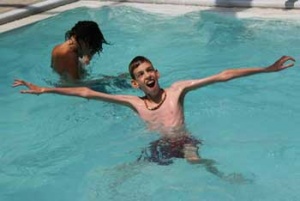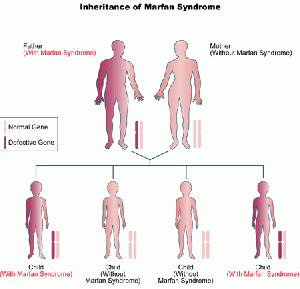Marfan Syndrome: Difference between revisions
Laura White (talk | contribs) No edit summary |
Laura White (talk | contribs) No edit summary |
||
| Line 26: | Line 26: | ||
== Characteristics/Clinical Presentation == | == Characteristics/Clinical Presentation == | ||
'''Musculoskeletal System'''<br>People with Marfan syndrome can display any or all of the following physical characteristics: tall, thin body build; long arms and legs (dolichostenomelia); elongated fingers and toes (arachnodactyly); unusually flexible joints; long narrow face; highly arched roof of the mouth; crowded teeth; small lower jaw; scoliosis; pes planus; pectus excavatum; pectus carinatum; and arm span that exceeds body height. <ref name="[1]" /><ref name="[3]" /><ref name="[4]" /><ref name="[6]" /><ref name="[7]" /><ref name="[8]" /><ref name="[9]" /> | |||
'''Ocular System''' <ref name="[5]" /><ref name="[6]" /><ref name="[7]" /><br>It is very common for people with Marfan syndrome to be myopic. Other ocular symptoms include early glaucoma and cataracts. More than half of those with Marfan syndrome will also experience dislocation of one or both lenses of the eye and possibly retinal detachment. | |||
'''Cardiovascular System'''<br>Patients with Marfan syndrome are at risk for a variety of cardiac problems, including: aortic root dilation; aortic valve regurgitation; aortic dissection, aneurysm, or rupture; mitral valve prolapse; bacterial endocarditis; cardiomyopathy; heart murmur; intracranial bleeding/Berry aneurysm; and heart failure.<ref name="[1]" /><ref name="[7]" /><ref name="[9]" /><ref name="[10]" /><ref name="[11]" /> A patient with these complications may complain of shortness of air, heart palpitations, and fatigue.<ref name="[3]" /> | |||
'''Nervous System'''<br>Patients with Marfan syndrome are at risk for dural ectasia later in life, which can be a source of discomfort or pain including low back pain, radiating pain/numbness to the abdomen or legs, bowel and/or bladder changes, and headache.<ref name="[2]" /><ref name="[7]" /><ref name="[8]" /> | |||
'''Pulmonary System''' <ref name="[2]" /><ref name="[5]" /><ref name="[7]" /><ref name="[8]" /><ref name="[9]" /><br>Patients with Marfan syndrome are at risk for recurrent spontaneous pneumothorax which can cause sudden pain (especially on one side of the chest) and/or shortness of air. These patients may also snore or experience sleep apnea. They are also at an increased risk for asthma, pneumonia, bronchitis, emphysema, and cystic lung disease due to the changes in the lung tissue that occur with Marfan syndrome. | |||
'''Integumentary System'''<br>Stretch marks that are unexplained by weight gain/loss or pregnancy are common in patients with Marfan syndrome.<ref name="[5]" /><ref name="[7]" /><ref name="[9]" /> They are also at an increased risk of developing hernias, especially abdominal or inguinal.<ref name="[7]" /><br><br> | |||
== Associated Co-morbidities == | == Associated Co-morbidities == | ||
Revision as of 04:31, 13 March 2011
Original Editors - Laura White from Bellarmine University's Pathophysiology of Complex Patient Problems project.
Lead Editors - Your name will be added here if you are a lead editor on this page. Read more.
Definition/Description [edit | edit source]
Marfan syndrome is a genetic disorder of the connective tissue affecting most notably the skeletal system, cardiovascular system, eyes, and skin, among other body systems.[1] Due to the widespread role of connective tissue throughout the body, individuals with Marfan syndrome may be at risk for many potentially severe or lethal co-moribidities as a result of the disease process. Marfan syndrome is inherited through an autosomal dominant mutation of the gene encoding glycoprotein fibrillin-1 (FBN1), which plays a role in the anchoring of cells to the extra-cellular matrix and is the main component of microfibrils .[2][3] Microfibrils affect the strength and elasticity of connective tissue, and also control the release of growth factors that cause growth and repair of tissues and organs throughout the body.[2] A defect in this gene means that the quality and/or quantity of fibrillin-1 in the body is decreased, reducing the amount available to form microfibrils, implicating changes in the body’s connective tissues and growth of tissues.[2] Marfan’s most widely known physical characteristics include a tall, thin build with long fingers, arms, and legs.[4]
[Photo courtesy of National Marfan Foundation. Available at www.marfan.org/marfan/2728/Physical-Activity-Guidelines]
Prevalence[edit | edit source]
Marfan syndrome affects approximately 1 in 5000 people and is equal between men and women as well as between races and ethnicities.[5][6] Marfan syndrome is an autosomal dominant disorder, meaning that children with one affected parent have a 50% chance of inheriting the genetic mutation.[3][4][7][8][9] However, it is estimated that 25% of people with Marfan syndrome did not inherit the disorder but instead experienced a spontaneous genetic mutation at conception of unknown cause.[3][5][7][8][9]
[Image courtesy of Heart.org.in. Available at www.heart.org.in/diseases/marfan-syndrome.html]
Characteristics/Clinical Presentation[edit | edit source]
Musculoskeletal System
People with Marfan syndrome can display any or all of the following physical characteristics: tall, thin body build; long arms and legs (dolichostenomelia); elongated fingers and toes (arachnodactyly); unusually flexible joints; long narrow face; highly arched roof of the mouth; crowded teeth; small lower jaw; scoliosis; pes planus; pectus excavatum; pectus carinatum; and arm span that exceeds body height. [1][3][4][6][7][8][9]
Ocular System [5][6][7]
It is very common for people with Marfan syndrome to be myopic. Other ocular symptoms include early glaucoma and cataracts. More than half of those with Marfan syndrome will also experience dislocation of one or both lenses of the eye and possibly retinal detachment.
Cardiovascular System
Patients with Marfan syndrome are at risk for a variety of cardiac problems, including: aortic root dilation; aortic valve regurgitation; aortic dissection, aneurysm, or rupture; mitral valve prolapse; bacterial endocarditis; cardiomyopathy; heart murmur; intracranial bleeding/Berry aneurysm; and heart failure.[1][7][9][10][11] A patient with these complications may complain of shortness of air, heart palpitations, and fatigue.[3]
Nervous System
Patients with Marfan syndrome are at risk for dural ectasia later in life, which can be a source of discomfort or pain including low back pain, radiating pain/numbness to the abdomen or legs, bowel and/or bladder changes, and headache.[2][7][8]
Pulmonary System [2][5][7][8][9]
Patients with Marfan syndrome are at risk for recurrent spontaneous pneumothorax which can cause sudden pain (especially on one side of the chest) and/or shortness of air. These patients may also snore or experience sleep apnea. They are also at an increased risk for asthma, pneumonia, bronchitis, emphysema, and cystic lung disease due to the changes in the lung tissue that occur with Marfan syndrome.
Integumentary System
Stretch marks that are unexplained by weight gain/loss or pregnancy are common in patients with Marfan syndrome.[5][7][9] They are also at an increased risk of developing hernias, especially abdominal or inguinal.[7]
Associated Co-morbidities[edit | edit source]
add text here
Medications[edit | edit source]
add text here
Diagnostic Tests/Lab Tests/Lab Values[edit | edit source]
add text here
Etiology/Causes[edit | edit source]
add text here
Systemic Involvement[edit | edit source]
add text here
Medical Management (current best evidence)[edit | edit source]
add text here
Physical Therapy Management (current best evidence)[edit | edit source]
add text here
Alternative/Holistic Management (current best evidence)[edit | edit source]
add text here
Differential Diagnosis[edit | edit source]
add text here
Case Reports/ Case Studies[edit | edit source]
add links to case studies here (case studies should be added on new pages using the case study template)
Resources
[edit | edit source]
add appropriate resources here
Recent Related Research (from Pubmed)
[edit | edit source]
Failed to load RSS feed from http://eutils.ncbi.nlm.nih.gov/entrez/eutils/erss.cgi?rss_guid=123Q1E1Q18WMxrWCl7C_qtsrt5g8Eo6A8spQWMhU4rlndOW9_D|charset=UTF-8|short|max=10: Error parsing XML for RSS
References[edit | edit source]
see adding references tutorial.
- ↑ 1.0 1.1 1.2 http://www.ncbi.nlm.nih.gov/pubmedhealth/PMH0001455
- ↑ 2.0 2.1 2.2 2.3 2.4 http://www.merckmanuals.com/professional/sec19/ch284/ch284d.html?qt=Marfan%20syndrome&amp;amp;amp;amp;amp;amp;amp;amp;amp;amp;amp;amp;amp;amp;amp;amp;amp;amp;amp;amp;amp;alt=sh
- ↑ 3.0 3.1 3.2 3.3 3.4 National Library of Medicine- Genetics Home Reference: http://ghr.nlm.nih.gov/condition/marfan-syndrome
- ↑ 4.0 4.1 4.2 Mayo Clinic: http://www.mayoclinic.com/health/marfan-syndrome/DS00540
- ↑ 5.0 5.1 5.2 5.3 5.4 National Marfan Foundation: http://www.marfan.org/marfan/
- ↑ 6.0 6.1 6.2 National Human Genome Research Institute: http://www.genome.gov/19519224
- ↑ 7.0 7.1 7.2 7.3 7.4 7.5 7.6 7.7 7.8 National Institute of Arthritis and Musculoskeletal and Skin Diseases: http://www.niams.nih.gov/Health_Info/Marfan_Syndrome/default.asp
- ↑ 8.0 8.1 8.2 8.3 8.4 National Heart Lung and Blood Institute’s Diseases and Conditions Index: http://www.nhlbi.nih.gov/health/dci/Diseases/mar/mar_whatis.html
- ↑ 9.0 9.1 9.2 9.3 9.4 9.5 9. Cleveland Clinic: http://my.clevelandclinic.org/heart/disorders/aorta_marfan/marfan.aspx
- ↑ Cite error: Invalid
<ref>tag; no text was provided for refs named[10] - ↑ Cite error: Invalid
<ref>tag; no text was provided for refs named[11]








